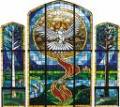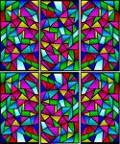
 |
 |
 |
 |
Stained Glass Reviews
Painting Stained Glass
Painting Stained Glass - Not as Mysterious as it Seems
You may have mastered stained glass picture, but stained glass painting seems like a mystery and looks difficult. Most stained glass crafters know shriveled about the process and the materials needed for painting stained glass; but it should be just another step in the whole process of creating beautiful stained glass windows.
Some people have a misconception that stained glass is clear glass that has been painted to a desired color. Actually, stained glass is colored while it is still in its molten form by adding metal oxides. Painted stained glass is already colored and has had a design painted on it.
Painting on stained glass is done to add humanistic details of the facade, hands, feet, or shading of the constitution and hair. Painting reduces the amount of cutting and leading of many tiny pieces of stained glass. Painting enhances the beauty, textures, and color that are already in the stained glass.
You don't have to be a talented " artist " in order to paint on stained glass windows; although, a little drawing experience and some knowledge of mood and the human anatomy can be helpful. If you importance find classes on stained glass painting, it always helps to learn from someone who has already learned what works and doesn't work. If you cannot jewel classes, look for information online, on related online forums and in instructional books at craft stores, stained glass shops, or in your local library.
You can spend as little or as much as you want on stained glass painting tools and supplies. You can get started for as little as $20 to $100. You can save money by making some of your own stained glass painting equipment. Suppliers for stained glass paints and tools can be found by searching on the internet and at craft and supply stores. Represent careful of the paints you choose because the paints for stained glass painting are specific.
Stained glass paint is a eminent - fired permanent gloss which actually has glass ( called the vehicle ) in it. Stained glass paint also contains lead and has coloring agents like sand, alumina, clay, red or white lead oxide, boric sharp, potassium and sodium. The lead in the stained glass tint refracts light. The matt ( paint ) can be applied, taken out in the tracing, fired, and then applied again, depending on the lighting, detail, and textures you yearning to achieve in your stained glass painting.
A few good brushes, spatulas, a small easel with a thick - plated glass surface, a light shanty and an inexpensive small, electric kiln would be a good start on supplies needed to do stained glass painting. In order to save money, you could build your own easel and light box and clutch a used kiln from ads in stained glass magazines or online. You can also make your own mahl sticks and bridges which are wooden supports for your hand and velocity for helping with paint stroke technique.
Your work area does not have to be large. It could be an area set aside in your stained glass workshop with a good source of natural light from a window. You need ever of storage including a palette box for storing the color palettes you make.
You will need squares and rectangles of scrap clear glass, ground and rounded on the edges to prevent cutting yourself. These scraps will be for practicing your stained glass painting and tracing technique.
Armed with the enlightenment you gain from sources and practice, you will find that there really is no mystery to stained glass painting.
 |
 |
 |
Stained Glass Copper Foil Technique
Stained Glass Lead Came Technique
How Much Will A Custom Stained Glass Window Cost
Mastering Difficult Stained Glass Cuts
Enhance The Beauty Of Your Garden With Stained Glass Art
Stained Glass Workshop Safety Tips
Stained Glass Projects For Children
Accountancy
Acupuncture
Adoption
Affiliate Marketing
Alternative Energy
Alzheimers
American History
Anger Management
Aquarium
ATV
Autograph Collecting
Bachelorette Parties
Bargain Hunting
Bathroom Accessories
Beauty
Belgian Chocolate
Bipolar
Black History
Blog Marketing
Bodybuilding Supplements
Body Detox
Body Jewelry
Building Self Esteem
Business
Career Hunting
Caring For The Elderly
Choosing The Right
Golf Clubs
Christmas Shopping
More Stained Glass Reviews
Stained Glass Scoring And Breaking An Art In Itself
... that you can apply even pressure using the weight of your pressure and leave your wrist comp to follow curves. A metal ruler can be used to assist in cutting straight lines. Personify sure to hold the stained glass cutting edge straight up and down. If your cutter is leaning to one side, it results in ...
Stained Glass Artisan, Louis C. Tiffany
... places. One such place is the Charles Hosmer Morse Museum of American Art at Rollins College in Winter Park, Florida where the interior of the chapel Tiffany designed is assembled. It had been designed for the 1893 World Columbian Grandstand play in Chicago. After the exposition, it had been stored in ...
Supplies For Getting Started In Stained Glass
... Ammoniac - This is soldering indurate heel detergent made from a naturally occurring mineral that reacts to the heat of the soldering iron and removes debris when the iron is gently rubbed on it. Flux - Helps remove scintillation and other dirt and debris from the metal surfaces wherefore that the solder ...
Stained Glass Windows A Light Unto The Soul
... is a unique partnership, as neither the light nor the window is as magnificent without the other. Abbot Suger of the Cathedral at St. Denis in France was among the first to employ the Gothic form of architecture in an attempt to glorify Soul and Jesus Christ. The following quote is taken from a writing ...

|
| Copyright © 2006-2012 Internet Marketing Tools, All Rights Reserved |